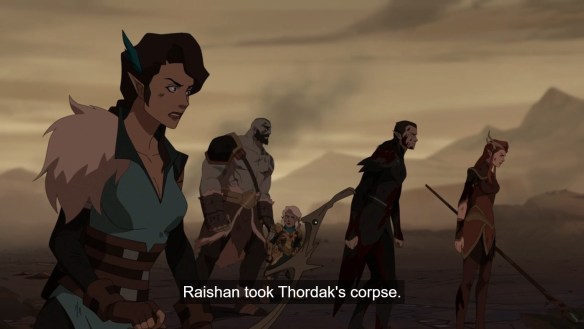Hello folks, and welcome the heck back to Wrong Every Time. Today we’re diving back into The Legend of Vox Machina, as our team nurses their wounds and plot their next course of action. The battle against Thordak nearly bested them, leaving earth rent and allies fallen, while offering little hope of truly ending this conflict. Kash and Percy are dead, Scanlan is unresponsive, and now Raishan possesses Thordak’s corpse, with which she is presumably getting up to even darker business than its original owner.
It’s all a gloomy, calamitous mess, which seems perfectly appropriate for this moment in the party’s journey. Traditional adventure narratives generally have their protagonists hit some “lowest point” just short of the climax, where all hope seems abandoned, darkest before the dawn, yada yada yada. However, this sort of dive in fortunes clashes with the mechanical inevitability of the party getting increasingly powerful as the journey proceeds, alongside the necessity of maintaining a degree of player agency as conflicts arise. Given all that, one way to square increasing party strength with the need for a narrative dive is to offer a false victory like this, where the achievement of the party’s goals only reveals a second, scale-shifting threat that they must rise to challenge, frequently without the aid of the companions that accompanied them in achieving their false victory. Properly seeded, such a twist respects both player agency and dramatic necessity, making it little surprise that “and now the true threat reveals itself” is such a staple of tabletop play and videogames alike.
As for my own DnD adventures, we just yesterday ran the first section of my frontier town module, and dear lord did that take a lot of out of me. My generally linear quest structure was indeed something of a crutch; with the party free to roam this town as they will, I had to spend the vast majority of the session “on” in terms of spontaneous invention and character acting, conducting emergent drama one hard-fought minute at a time. But nothing in DMing comes easy, and so far my actual players seem to be having a wonderful time lurking in saloons and fixing card games and generally making a nosy nuisance of themselves. I’ll let you know how that proceeds, but for now, we’re back to the action!
Episode 10
We open with just a touch more Raishan gloating before she warps away. Obviously introducing a new threat in this manner runs the risk of making the players feel like their previous efforts didn’t matter, but so long as the emergent threat feels like an escalation of preexisting concerns, it’s generally not a problem. For my own campaign, shifting from an army that was manipulating infernal energy to the infernal powers themselves was a natural jump – for Vox Machina, Raishan’s been a dubious ally right from the start
Of course, I gotta admit that Raishan’s series of betrayals and counter-betrayals here was a bit clumsy. That much jumping sides makes it feel a bit more like this is Raishan’s story and Vox Machina are just watching it
Keyleth is understandably upset that no one believed her about Raishan. These players are fantastic at letting their distinct character perspectives create interpersonal friction. My own party has gotten a lot better at that in our post-campaign sessions; it took a while for them to move beyond a sort of “collective voice” making in-session decisions
Keyleth flies off in a huff, telling the team not to follow her
The gang retire to their ruined villa. I was pretty surprised when Mercer chose to first award it and then immediately destroy it, but I actually like how its decaying yet salvageable status echoes the party and world’s general fortunes. It is useful to have totems that represent security in your campaign, if only for the easy dramatic cue of seeing those totems threatened
Vex wishes to hunt down Ripley, and sees the team as basically finished. Vex is generally excellent for creating friction within the group; “why are we even traveling together” can be a dangerous question for a group that can’t actually answer that question, but Vex wields it skillfully
Meanwhile, Pike hunts down Kaylie in order to revive Scanlan
“Are the two of you…” “We don’t need to talk about that!” One of my personal favorite conversational beats – a neutral party forcing one member of a “will they-won’t they” situation to awkwardly analyze their own feelings. My players aren’t quite confident enough in roleplay to pursue their own in-game romances, but I’ve certainly had them play the neutral party before
This episode in general is proving a credit to Vox Machina’s individual character arc-sculpting. It’s the classic “the party breaks up and reckons with who they are individually, then ultimately reaffirms they are stronger together” beat, but pulling that off demands a cast who actually have enough group-independent identity to each experience their own homecomings. Given that, it’s little surprise that Grog, Pike, and Scanlan’s arcs are combined – there actually isn’t enough of them individually to support such a sequence, so Grog and Pike are basically hitching a ride on Scanlan’s backstory
Keyleth’s reconciliation with her father doubles as the next narrative step forward, as she is informed of a ritual that might locate Raishan
I generally try to avoid such easy magical contrivances – I feel like one can swiftly get too comfortable saying “there’s a secret spell that does exactly what you need at this moment” to answer any narrative hurdle, when in truth I should be endeavoring to make the path forward something the players can recognize and pursue for themselves. When you’re writing both a conflict and its solution, it feels kinda hack to make that solution “the secret conflict-resolving spell”
Ooh, love this Blighttown-esque village of Stilben that the twins are visiting. I’ve long wanted to construct a thieves’ quarter leaning into Kowloon-esque verticality, but verticality is a tricky thing to realize in DnD
The Ashari council offer a couple bombshells to Keyleth: first, that they were the ones responsible for cursing Raishan, and second, that her mother disappeared after meddling with the same kind of magic Keyleth is pursuing
Her request is ultimately denied
Over in Stilben, Vax stalks a cat man wielding a pepperbox. Tracking a target across an urban environment is a natural adventure beat that is almost too easily resolved in DnD, as it can easily be distilled into “roll a stealth check.” If I wanted to foster more gameplay in such a situation, I’d perhaps draw a map and have the tracking proceed in turn structure, with the pursuer picking hiding spots and rolling individual stealth checks weighted by how well they’re choosing their actions
And then Keyleth returns to the council, putting her experience being downplayed and ignored by the team to work insisting that this council shut up and listen
She plays a good angle here, basically accusing the council leader of overriding the rightful voices of her compatriots
Keyleth’s growing confidence as a character seems aligned with the confidence of her player; an excellent, natural arc for both of them
She is taken to a sacred shrine to learn the ritual. My background in more traditional fiction naturally chafes against DnD’s tendency to continue stories with groundless “and then this new thing happens” contrivances – I know that’s not uncommon in tabletop fantasy, but my instinct leans towards ensuring new complications emerge naturally as consequences of prior actions, not to just send arbitrary threats or challenges at my players. Even my post-campaign conflicts are being framed as consequences of the power vacuum left by my players’ prior successes; it would feel like a fail state to simply embrace “suddenly, an unprompted threat arrives to fuck everything up”
Of course, that rule of thumb is itself situational. Great stories can create their own sense of cohesion through tone, repeated motifs, or thematic echoes – One Hundred Years of Solitude is not lesser for disregarding canned “Save the Cat” screenwriting truisms. But for DnD, such subtle methods of cohesion are less effective
Speaking of thematic echoes, they’re doing a nice job of balancing Keyleth and Vex’s anxieties across these paired narratives. Again, methods of narrative cohesion are often medium-specific, and this sort of cross-cutting is a useful shorthand for this adaptation
Both of their journeys reach the same conclusion: rather than the enemy they are pursuing, they are guided back towards the friends they’re leaving behind
And Done
Thus our twins find themselves in a whole heap of trouble, having run well ahead of the team and straight into the claws of Anna Ripley. As expected, this was something of a cooldown episode in the wake of all that calamitous dragon business, focusing primarily on exploring how this awkward fork in the road challenges both their individual and group identities. Characters like Keyleth and the twins have at this point accumulated enough emotional baggage to essentially be self-starters in terms of narrative drama; even the lack of a clear direction served as direction enough to guide them, with this adaptation’s tools of aesthetic convergence allowing some fairly disparate stories to feel at least emotionally cohesive. Tabletop campaigns are unwieldy organisms, their fluidity of authorship making them hard to compare to traditional narratives, but a proper union of DM and players can feel like building a fantasy epic one emergent twist at a time. Now let’s get the band back together!
This article was made possible by reader support. Thank you all for all that you do.




